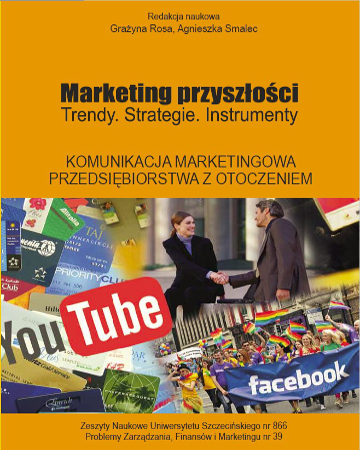
ISSN: 1509-0507
eISSN: 2353-2874
OAI
DOI: 10.18276/pzfm.2015.39-20



Issue archive /
ZN 866 PZFiM nr 39
Wpływ wejścia nowego podmiotu do lubelskiego sektora centrów handlowych na sposób postrzegania aktualnych graczy rynkowych
(The Impact of the Entry of a New Company to the Lublin Shopping Centers Sector on the Perception of Current Market Players)
| Authors: |
Łukasz
Skowron
Politechnika Lubelska |
| Keywords: | customer satisfaction shopping centers path relation analysis competition |
| Data publikacji całości: | 2015 |
| Page range: | 12 (245-256) |
Abstract
The paper presents the author's own research results describing the process of shaping satisfaction of customers of Lublin shopping centers. The research was conducted on the group of over 2000 customers in two research periods (2013 and 2014; approximately 1000 customers in every reporting period). Because of the new market player appearance in the discussed sector the intensification of competition occurred in the interval between performed examinations (that increased the number of the big shopping centers from 3 to 4 in the discussed city). Thanks to conducted analyses it was possible to demonstrate how the appearance of the new market entity influences the prospective customers’ perception of the evaluation of individual functioning aspects of discussed centers as well as the of the overall process of shaping their satisfaction and loyalty.
Download file
Article file
Bibliography
| 1. | Chin W.W. The partial least squares approach to structural equation modelling, w: Modern methods for business research, red. G.A. Marcoulides, Lawrence Erlbaum, New Jersey 1998. |
| 2. | Chin W.W., Marcolin B.L., Newsted P.N., A partial least squares approach for measuring interaction effects: Results from a Monte Carlo simulation study and an electronic mail emotion/adoption study, „Information Systems Research” 2003, Vol. 14, Iss. 2. |
| 3. | Henseler J., Ringle C.M., Sinkovics R.R., The use of partial least squares path modeling in international marketing, „Advances in International Marketing” 2009, Vol. 20. |
| 4. | Kristensen K., Eskildsen J., Design of PLS-Based Satisfaction Studies, w: Handbook of Partial Least Squares, red. V.E. Vinzi, W.W. Chin, J. Henseler, H. Wang, Springer Handbooks of Computational Statistics, Springer, 2010. |
| 5. | Skowron Ł., Satysfakcja i lojalność klienta – ujęcie modelowe i wyniki badań, w: Zarządzanie wartością klienta. Pomiar i strategie, red. B. Dobiegała-Korona, T. Doligalski, Poltext, Warszawa 2010. |
| 6. | Skowron Ł., Modele ścieżkowe jako przykładowe metody badania satysfakcji i lojalności klientów, w: Marketing przyszłości – Trendy. Strategie. Instrumenty, red. G. Rosa, A. Smalec, Zeszyty Naukowe Uniwersytetu Szczecińskiego nr 594, Ekonomiczne Problemy Usług nr 54, Wyd. Naukowe Uniwersytetu Szczecińskiego, Szczecin 2010. |
| 7. | Skowron Ł., Wykorzystanie modelu EPSI w badaniach lojalności klienta usług banko-wych w wybranych krajach Unii Europejskiej, w: Badania marketingowe – skuteczność w zarządzaniu przedsiębiorstwem, red. K. Mazurek-Łopacińska, Prace Naukowe Uniwersytetu Ekonomicznego we Wrocławiu nr 97, Wyd. Uniwersytetu Ekonomicznego, Wrocław 2010. |
| 8. | Skowron Ł., Zastosowanie modelowania ścieżkowego do wyznaczania przebiegu procesu lojalnościowego wśród klientów lubelskich centrów handlowych, w: Badania marketingowe – nowe podejścia oraz metody na współczesnym rynku, red. K. Mazurek-Łopacińska, M. Sobocińska, Prace Naukowe Uniwersytetu Ekonomicznego we Wrocławiu nr 336, Wyd. Uniwersytetu Ekonomicznego, Wrocław 2014. |